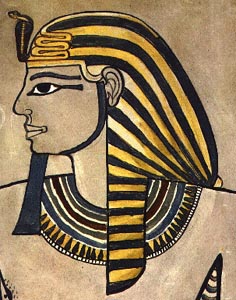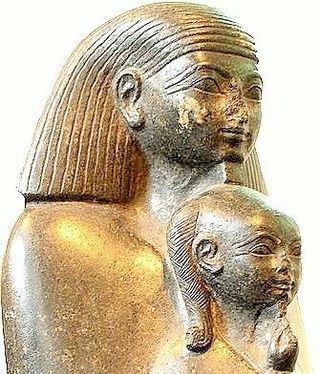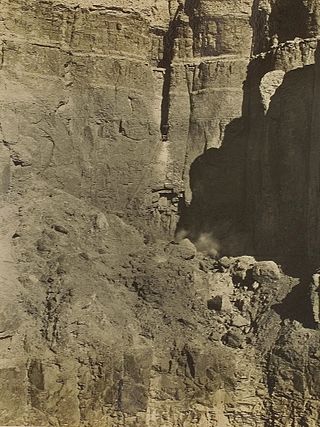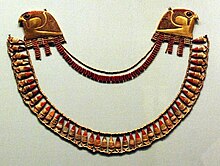
Hatshepsut was the Great Royal Wife of Pharaoh Thutmose II and the fifth Pharaoh of the Eighteenth Dynasty of Egypt, ruling first as regent, then as queen regnant from c. 1479 BC until c. 1458 BC. She was Egypt's second certain queen regnant, the first being Sobekneferu/Nefrusobek in the Twelfth Dynasty.

Thutmose III, sometimes called Thutmose the Great, was the sixth pharaoh of the 18th Dynasty. Officially, Thutmose III ruled Egypt for almost 54 years and his reign is usually dated from 28 April 1479 BC to 11 March 1425 BC, from the age of two and until his death at age fifty-six; however, during the first 22 years of his reign, he was coregent with his stepmother and aunt, Hatshepsut, who was named the pharaoh. While he was shown first on surviving monuments, both were assigned the usual royal names and insignia and neither is given any obvious seniority over the other. Thutmose served as the head of Hatshepsut's armies. During the final two years of his reign, he appointed his son and successor, Amenhotep II, as his junior co-regent. His firstborn son and heir to the throne, Amenemhat, predeceased Thutmose III.

The tomb of Tutankhamun, also known by its tomb number, KV62, is the burial place of Tutankhamun, a pharaoh of the Eighteenth Dynasty of ancient Egypt, in the Valley of the Kings. The tomb consists of four chambers and an entrance staircase and corridor. It is smaller and less extensively decorated than other Egyptian royal tombs of its time, and it probably originated as a tomb for a non-royal individual that was adapted for Tutankhamun's use after his premature death. Like other pharaohs, Tutankhamun was buried with a wide variety of funerary objects and personal possessions, such as coffins, furniture, clothing and jewelry, though in the unusually limited space these goods had to be densely packed. Robbers entered the tomb twice in the years immediately following the burial, but Tutankhamun's mummy and most of the burial goods remained intact. The tomb's low position, dug into the floor of the valley, allowed its entrance to be hidden by debris deposited by flooding and tomb construction. Thus, unlike other tombs in the valley, it was not stripped of its valuables during the Third Intermediate Period.

Thutmose I was the third pharaoh of the 18th Dynasty of Egypt. He received the throne after the death of the previous king, Amenhotep I. During his reign, he campaigned deep into the Levant and Nubia, pushing the borders of Egypt farther than ever before in each region. He also built many temples in Egypt, and a tomb for himself in the Valley of the Kings; he is the first king confirmed to have done this.

Thutmose II was the fourth Pharaoh of the Eighteenth Dynasty of Egypt, and his reign is generally dated from 1493 to 1479 BC. Little is known about him and he is overshadowed by his father Thutmose I, half-sister and wife Hatshepsut, and son Thutmose III. He died around the age of 30 and his body was found in the Deir el-Bahri Cache above the Mortuary Temple of Hatshepsut.

Amenhotep II was the seventh pharaoh of the Eighteenth Dynasty of Egypt. Amenhotep inherited a vast kingdom from his father Thutmose III, and held it by means of a few military campaigns in Syria; however, he fought much less than his father, and his reign saw the effective cessation of hostilities between Egypt and Mitanni, the major kingdoms vying for power in Syria. His reign is usually dated from 1427 to 1401 BC. His consort was Tiaa, who was barred from any prestige until Amenhotep's son, Thutmose IV, came into power.

Deir el-Bahari or Dayr al-Bahri is a complex of mortuary temples and tombs located on the west bank of the Nile, opposite the city of Luxor, Egypt. This is a part of the Theban Necropolis.

Tomb KV60 is an ancient Egyptian tomb in the Valley of the Kings, Egypt. It was discovered by Howard Carter in 1903, and re-excavated by Donald P. Ryan in 1989. It is one of the more perplexing tombs of the Theban Necropolis, due to the uncertainty over the identity of one female mummy found there (KV60A). She is identified by some, such as Egyptologist Elizabeth Thomas, to be that of the Eighteenth Dynasty pharaoh Hatshepsut; this identification is advocated for by Zahi Hawass.

Tomb WV22, also known as KV22, was the burial place of the Eighteenth Dynasty pharaoh Amenhotep III. Located in the Western arm of the Valley of the Kings, the tomb is unique in that it has two subsidiary burial chambers for the pharaoh's wives Tiye and Sitamen. It was officially discovered by Prosper Jollois and Édouard de Villiers du Terrage, engineers with Napoleon's expedition to Egypt in August 1799, but had probably been open for some time. The tomb was first excavated by Theodore M. Davis, the details of which are lost. The first documented clearance was carried out by Howard Carter in 1915. Since 1989, a Japanese team from Waseda University led by Sakuji Yoshimura and Jiro Kondo has excavated and conserved the tomb. The sarcophagus is missing from the tomb. The tomb's layout and decoration follow the tombs of the king's predecessors, Amenhotep II (KV35) and Thutmose IV (KV43); however, the decoration is much finer in quality. Several images of the pharaoh's head have been cut out and can be seen today in the Louvre.

Tomb KV42 is an ancient Egyptian tomb located in the Valley of the Kings in Egypt. It was constructed for Hatshepsut-Meryetre, the wife of Thutmose III, but she was not buried in the tomb. It may have been reused by Sennefer, a mayor of Thebes during the reign of Amenhotep II, and by several members of his family. The tomb has a cartouche-shaped burial chamber, like other early Eighteenth Dynasty tombs.

Tomb KV43 is the tomb of Pharaoh Thutmose IV in the Valley of the Kings in Luxor, Egypt. It has a dog-leg shape, typical of the layout of early 18th Dynasty tombs. KV43 was rediscovered in 1903 by Howard Carter, excavating on behalf of Theodore M. Davis.

KV20 is a tomb in the Valley of the Kings (Egypt). It was probably the first royal tomb to be constructed in the valley. KV20 was the original burial place of Thutmose I and later was adapted by his daughter Hatshepsut to accommodate her and her father. The tomb was known to Napoleon Bonaparte's expedition in 1799 and had been visited by several explorers between 1799 and 1903. A full clearance of the tomb was undertaken by Howard Carter in 1903–1904. KV20 is distinguishable from other tombs in the valley, both in its general layout and because of the atypical clockwise curvature of its corridors.

KV4 is a tomb in the Valley of the Kings (Egypt). The tomb was initiated for the burial of Ramesses XI but it is likely that its construction was abandoned and it was not used for Ramesses's interment. It also seems likely that Pinedjem I intended to usurp this tomb for his own burial, but that he too abandoned the plan. KV4 is notable for being the last royal tomb that was quarried in the Valley and because it has been interpreted as being a workshop used during the official dismantling of the royal necropolis in the early Third Intermediate Period.

Tomb KV36 is the burial place of the noble Maiherpri of the Eighteenth Dynasty in the Valley of the Kings, Egypt.

Neferure or Neferura was an Egyptian princess of the Eighteenth Dynasty of Egypt. She was the daughter of two pharaohs, Hatshepsut and Thutmose II. She served in high offices in the government and the religious administration of Ancient Egypt.

The tomb of Kha and Merit, also known by its tomb number TT8, is the funerary chapel and tomb of the ancient Egyptian foreman Kha and his wife Merit, in Deir el-Medina. Active during the mid-Eighteenth Dynasty, Kha supervised the workforce who constructed royal tombs in the reigns of pharaohs Amenhotep II, Thutmose IV and Amenhotep III. Of unknown background, he rose to this position through skill and was rewarded by at least one king. He and his wife Merit had three known children. Kha died in his 50s or 60s, while Merit died before him, seemingly unexpectedly, in her 30s.

Djehuty was a general under the ancient Egyptian king Thutmose III in the 18th Dynasty. He is known as the main hero of the tale of "The Taking of Joppa". Djehuty bears the titles king's scribe, overseer of troops (general) and overseer of the northern foreign countries in contemporary Egyptian records.

Mayet was an ancient Egyptian girl buried in the mortuary temple of King Mentuhotep II at Deir el-Bahari. Her burial was found intact. Her position within the royal family of Mentuhotep II is disputed.

Egyptian finger and toe stalls are pieces of gold jewelry used in Ancient Egypt to protect digits during burial. Such stalls were used during the 18th Dynasty of Egypt, as well as other eras, and were thought to protect the deceased from both magical and physical dangers, such as damage which could occur during the mummification process. Additionally, they were sometimes used in order to replace missing digits on the deceased, as it was believed that a complete body was needed for successful passage into the afterlife. This belief mirrors the myth of Osiris, whose body was put back together by his wife Isis, resulting in him becoming the first mummy. Some mummies were buried with prosthetics which they used in life, rather than toe stalls created specifically for burial. These stalls were most commonly found on the remains of royalty. Toe stalls were discovered in the tomb of Tutankhamun, and a nearly complete set of finger and toe stalls was discovered in the tomb of three of the wives of Thutmose III in Thebes. The wives' jewelry is currently on display at the Metropolitan Museum of Art. The stalls from this tomb are some of the earliest known, originating from the early 18th Dynasty. A later surviving example of toe stalls comes from the tomb of Psusennes I, a 21st Dynasty ruler. Although many surviving examples of finger and toe stalls originate from the 18th Dynasty, they were used for much of Ancient Egypt, including into the Ptolemaic and Roman periods. For example, one mummy from this period was found with carved golden finger stalls, similar to those discovered from earlier periods. Though royalty and the upper classes typically had stalls made of gold or silver, less wealthy Egyptians utilized other materials, including wood, stone, and/or mud. In order to provide magical protection for the deceased, a prayer was made to Osiris as the stalls were created. The stalls were often highly detailed, with carved nails and other features, such as rings.

The cliff tomb of Hatshepsut, also referred to as tomb Wadi A-1, is the tomb quarried for her as Great Royal Wife of Thutmose II. It is located in Wady Sikkat Taqet Zaid, to the west of the Valley of the Kings near Luxor, Egypt. The tomb is cut into a slot in the vertical cliff face 70 metres (230 ft) above the valley floor. It is unfinished, with the cutting of the burial chamber never being completed. Although never used for a burial, it did contain a sarcophagus inscribed for Hatshepsut as Great Royal Wife. Originally found by local diggers, the tomb was later excavated by Howard Carter on behalf of the Earl of Carnarvon in 1916.






























